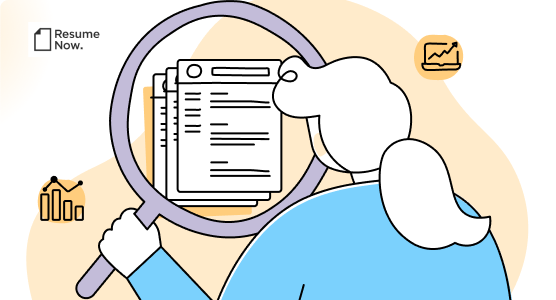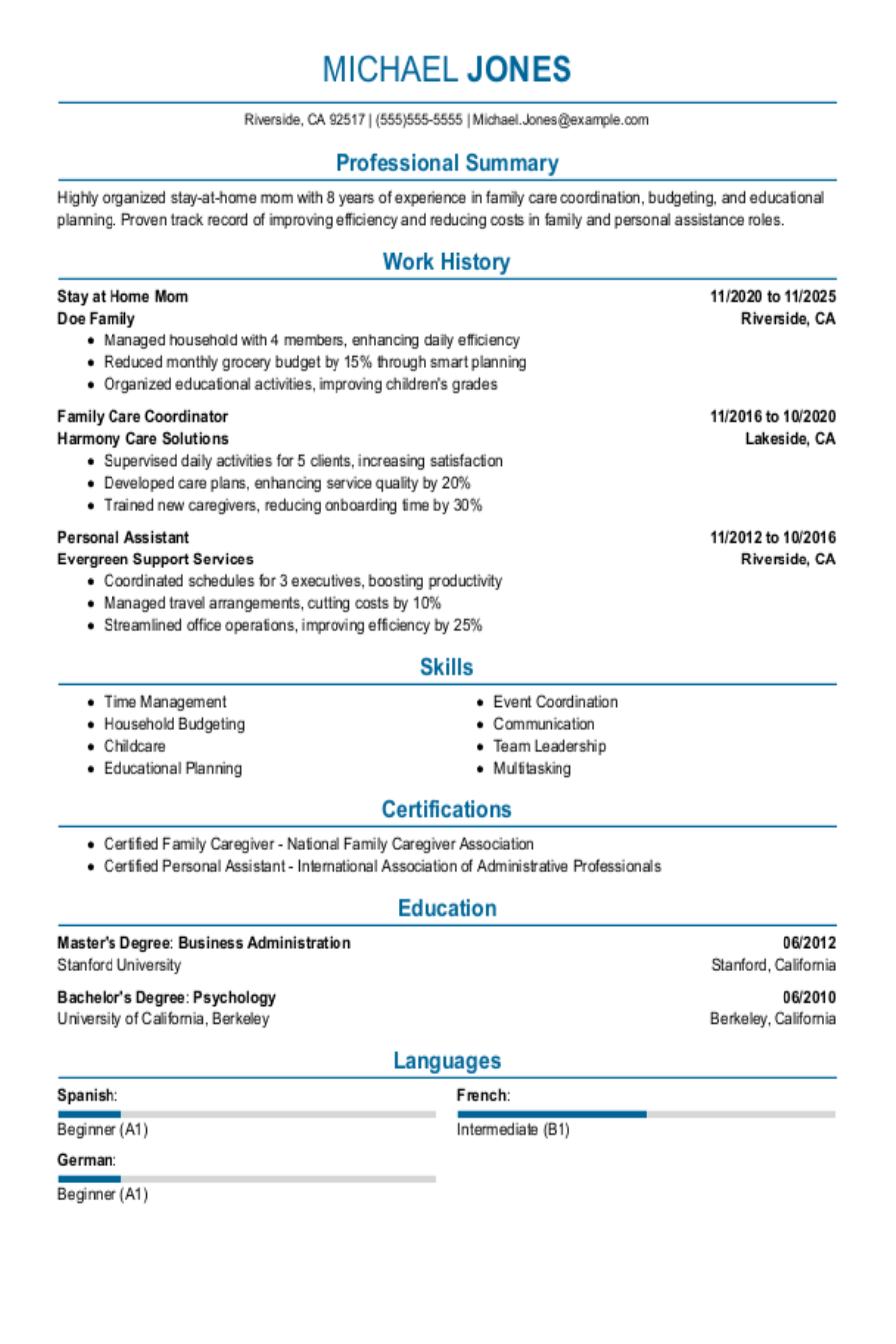Writing a cover letter is an important milestone on your road to landing an exciting new opportunity. While getting started can come with a lot of uncertainty, we're here to shed some light on your journey. Our guide will help you get started with some cover letter basics, including tips and examples, to simplify the writing process.
Our guide includes:
- A quick cover letter definition and reasons why you should write a persuasive one.
- A simple breakdown of what goes into a cover letter.
- A cover letter example that you can reference to help get you started.
- Tips to remember as you work on your letter.
Need a cover letter in a hurry? Our Cover Letter Generator lets you jump right into building an impressive cover letter with the help of customizable text suggestions based on your input, automatic formatting and sleek templates that you can match to your resume.
What Is a Cover Letter?
A cover letter is a document that you submit along with your resume to introduce yourself to an employer and express interest in a job.
You might ask: Doesn't my resume give the employer all the information they need? Why should I write a second document explaining my qualifications? It's a good question, but there are some key reasons why a cover letter is worth the effort, even if you've written the perfect resume.
Why write a cover letter?
Writing a cover letter might seem like an extra step, but it serves a very important role. Here are some of the reasons why you need one:
- It adds context to your resume. Your resume is a formal list of your qualifications. That means that if you have unique circumstances like resume gaps or an unconventional career path, your resume doesn't give you a chance to explain them. Enter the cover letter! One of the cover letter's basic purposes is to allow you to tell your story.
- It targets a specific role. Regardless of the role you're applying to, your resume gives a general overview of your career history — even when you tailor it to each role you apply for. That's why a cover is so important. Each one you write should be focused on the specific role it's intended for. Your cover letter should explain why you're interested in the position and what makes you a good fit.
- It gives you more space. Resume real estate is often limited. Your cover letter is a can't-miss opportunity to communicate more. Take your most relevant and impressive accomplishments and draw the employer's attention to them.
- It shows effort. One of the most critical reasons why you need a cover letter is simply that many employers expect them. Even if they aren't specifically requested, employers notice when candidates take the extra time and effort to communicate. When desirable open roles sometimes get hundreds of applicants, being the person who wrote a persuasive cover letter can really help you stand out.
How to Write a Basic Cover Letter
Now that we've covered what a cover letter is and why you should write one, let's dive into the cover letter basics and discover what goes into a job-winning letter.
Start with your resume
It might seem odd that the first basic cover letter tip is actually about your resume, but hear me out: Your cover letter should expand on your resume. Writing your cover letter without an up-to-date resume to work with is a lot like starting on a journey without a roadmap.
Use your resume as a starting point to organize your qualifications and get a sense of which aspects of your career path you should draw attention to in your letter.
Need a hand writing your resume? Try our Resume Builder for a quick and easy solution.
Nail the cover letter formatting basics
Often, job-seekers are most intimidated by the formatting aspect of building career documents. This is understandable. All those fiddly little rules can make it feel like you're bound to mess up somewhere.
But if you stick to the basic cover letter formatting rules, you have nothing to worry about! As you build your letter, keep these tips in mind:
- A cover letter should use a simple, professional font like Arial, Calibri or Times New Roman. Your font size should be between 10 and 12 points and should be consistent throughout your document.
- Use 1-inch margins all around your document to achieve the right white space balance.
- Make sure to space your lines between 1.15 and 1.5 to make your content easy to read and scannable at a glance.
Following these simple rules will get you well on your way to creating a professionally formatted cover letter.
To avoid uncertainty and give your letter polish, choose a simple cover letter template that follows these rules, matches your resume template and aligns with your professional brand.
Review the job description
A cover letter should never be a generic list of qualifications that you reuse from one application to the next. Make sure your letter is written to specifically target the job you're pursuing. Incorporate keywords from the job description to show how well you match their needs.
This will help show employers how well you fit their needs and give your letter a leg up if it is scanned by an applicant tracking system (ATS) that filters for qualified candidates based on the presence of keywords.
Include your contact information in the header
As simple as it is, there's nothing more important than your cover letter header. The end goal of your cover letter is to get employers to contact you for an interview. To do that, they need to know how to reach you. Make sure you receive the interview invite by building a header that displays your:
- Full name.
- City and state.
- Phone number.
- Email address.
A basic cover letter header only needs the information listed above, but you can elevate this section and show off your networking skills by including links to your personal website, portfolio or even your LinkedIn profile.
Address the hiring manager by name
Your cover letter is a letter, so it needs to be addressed to someone. Usually, you'll address your letter to the hiring manager for the role.
Do a bit of digging if you need to, so you can find out the hiring manager's name and address your letter to them directly. If finding a name isn't possible, then address your letter as "Dear Hiring Manager" instead.
Introduce yourself in the first paragraph
Now that we've covered the basics of preparing your cover letter for writing, it's time to work on your content! You should begin your letter with a short and simple introduction that explains who you are, your professional background and why you're a great fit for the role.
Make sure to keep this section short and sweet. The details will come later.
Example basic cover letter opening paragraph:
I am excited to apply for the shift supervisor role at Mom and Pop's Cafe. With my background in retail and my track record of excellent customer service, I am confident that I can bring valuable expertise and contribute to the success of your team. I have a strong passion for the food service industry, and I am eager to use my leadership skills to bring exceptional dining experiences to your guests.
Explain why you're the best candidate for the role
Now it's time for your body paragraphs, which is where you get to go into all the details.
In this section, you'll explore specific experiences, skills and accomplishments that demonstrate why you're the perfect candidate. The job description should give you clues as to which professional skills and achievements to focus on.
Make your body paragraphs shine by using numbers to demonstrate your impact. Giving employers a real-world sense of what you can do will inspire confidence and prove that you know what you're talking about.
Example body paragraphs for a basic cover letter:
In my previous role as a team lead at Daphne's Diner, I successfully managed a team of 14 employees, ensuring that daily operations ran smoothly and efficiently. I am adept at handling high-pressure environments and am skilled at problem-solving, whether it's resolving a customer complaint or addressing operational challenges. During my tenure at Daphne's Diner, customer satisfaction survey results improved by 65%. I believe that maintaining a positive and organized work environment is key to delivering excellent customer service, and I always strive to lead by example.
Additionally, I have a strong foundation in training and mentoring staff. I take pride in helping employees grow and develop their skills, ensuring they provide high-quality service to each guest. At Mom and Pop's Cafe, I would be eager to bring these leadership and team-building skills to enhance productivity and create a welcoming atmosphere for both staff and customers. I am excited about the opportunity to contribute to the cafe's reputation for outstanding service and a warm, community-centered experience.
Write your cover letter closing
And just like that, you're ready to close your cover letter. But even a basic cover letter needs to end on a strong note. Write a closing paragraph that:
- Explains why the role excites you.
- Describes how you intend to contribute to the role.
- Invites further discussion in an interview.
- Thanks the reader for their time and consideration.
Example closing paragraph:
I am enthusiastic about the opportunity to join Mom and Pop's Cafe as a shift supervisor and become a part of your customer-focused team. I am confident that my experience in retail management, passion for customer service and dedication to creating a positive team environment would make me a valuable addition to your staff. I look forward to the possibility of discussing how my skills can benefit your cafe. Thank you for your time and consideration.
Sign off appropriately
Conclude your letter with a professional signoff. You shouldn't end with something that's too stiff or too casual. We recommend the tried and true options of "Sincerely" or "Best regards," followed by your name.
Basic Cover Letter Example
Now that you know the cover letter basics, let's look at an example cover letter that you can use for inspiration as you get started.
Were you hoping for an example that matches your career better? Check out our library of cover letter examples for specific examples designed to represent hundreds of careers.
Wondering how long a cover letter should be? A good rule of thumb is to stay between half a page and a full page. Your cover letter should never be longer than one page and your content should be concise and focused without unnecessary fluff.
Key Takeaways
Expand on your resume
Start with your resume to give you a strong foundation to build your cover letter on. Your letter should add context to details from your resume and draw attention to the qualifications that make you a good fit for the role.
Research the role
Your letter should be targeted to the specific role and should use keywords from the job description to show employers how well you fit their needs.
Master the basics of cover letter formatting
Stick to a simple style and use professional fonts and consistent margins to create a polished and cohesive cover letter.
Write a brief introduction
Open your letter by introducing yourself and your professional background. This section should be brief but impactful.
Write a detailed body
Expand on the accomplishments on your resume by describing them in your body paragraphs. Focus on essential skills that you wish to highlight alongside measurable outcomes that show what you can do.
Finish strong
Your cover letter should close with a neat reminder of why you're the right choice. Be confident but humble as you ask to discuss the role further in an interview and end with an appropriate signoff.
Resources to Help With Your Job Search
- 21st Century Skills for Your Resume
- Networking Skills for Your Resume
- The Perfect Resume: A Detailed Guide for 2025 (+Examples)
- How to Write a CV: The Complete Guide for 2025
- How to List References for a Resume With No Experience
- How to Update Your Resume in 2025 (Guide + Expert Tips)
- How to Prepare for a Job Interview
Was this information helpful? Let us know!
Hailey is a career advice writer dedicated to helping job seekers excel in their careers.
More resources

Only 1 in 10 Resumes Include Measurable Results, New Analysis of 18.4M U.S. Resumes Finds
Resume Now takes a closer look at measurable results on resume...

Top Entry‑Level Careers That Are Fast‑Growing, Higher‑Paying, and AI‑Resistant
Artificial intelligence is touching more parts of work every y...

What Does It Mean if an Interviewer Says "Good Luck" or "We'll Be In Touch"?
Read on to learn the meaning behind these standard post-interv...

Student Resume: 2025 Examples & Templates
Check out our guide for help writing a job-winning student res...

Stay At Home Mom Resume: Examples, Templates and Tips
Was this information helpful? Let us know &star &star &star &s...

Teen Resume: Examples, Template & Advice for Beginners
Whether you re looking for an internship or your first job a ...
